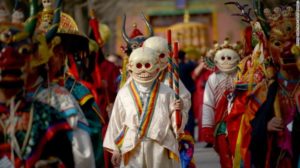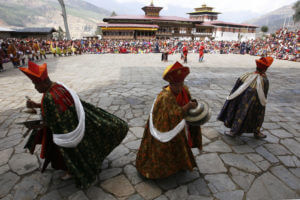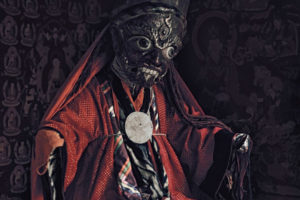 7
7




 7
7

 2
2

 21. 04. 2024
21. 04. 2024

 20. 04. 2024
20. 04. 2024
 4
4

 19. 04. 2024
19. 04. 2024
 01. 12. 2017
01. 12. 2017

Tibet is a mountainous, rugged country where settlers literally have to fight for survival. It does not surprise anyone that even the faith, which was born in such difficult conditions, was no less harsh than life itself…
When a German expedition set out for Berlin from Tibet in 1938, the Germans surprisingly contacted the Dalai Lama and other Tibetans relatively quickly. They also allied with the priests of the Tibetan religion bon (bonpo). They then not only allowed German scientists to explore their homeland and communicate with the local population, but also to film their mysterious rituals.
What gained Tibetan priests so convincingly that they allowed foreigners what they usually did not even allow their own compatriots? The guests came from a distant land that elevated the swastika to the level of a national symbol - the same swastika that had been worshiped in Tibet for centuries.
Gods and demons
Before Indian Buddhism entered these hard-to-reach reaches of the mountain range, Tibetans worshiped spirit, god, and demon. These higher beings had only one task - to destroy people. Man was terrorized by water demons, earth spirits, and heavenly gods, and they were all very cruel.
The world of the Tibetans had a threefold structure: the white heavens were inhabited by gods and good spirits Lha, the red earth was inhabited by humans and many bloodthirsty spirits (dead dead warriors who did not find peace) and the blue waters were an analogy of hell, from which the ruthless killers themselves emerged.
 Priests in costumes of Tibetan demons
Priests in costumes of Tibetan demons
Clearly, the kindness of the gods, their affection and protection, needed to be encouraged. Therefore, they prayed to them and offered sacrifices to them. Evil spirits and demons had to be appeased, prayed, and sacrificed. They also prayed for the protection of the White God of Heaven and his wives, whom they considered benevolent to humans, as well as to the Black Goddess of the Earth and the cruel Red Tiger and the Wild Dragon.
The nature of Tibet and the constant invasions of enemies did not allow people to relax, but they believed that after death they would find themselves in a better place and in a new young body - among the gods in heaven.
Scientists believe that the current bon religion was formed from pagan cult, Iranian Mazdaism and Indian Buddhism. But the basis of the bon religion was shamanism. Although it would be more accurate to call him a special pagan practice. By the time Buddhism was consolidated in Tibet (XNUMXth-XNUMXth centuries), the bon religion was already fully formed. In a way, it was a national religion.
The Tibetans had their pantheon of gods and heroes and formed myths about demons and evil spirits. Priests performed ceremonies, buried the dead and performed miracles that all Tibet believed. They even treated the sick and raised the dead. Many of them were climbing before setting out on a long journey, asking the priest for help. And so no event in people's lives went unnoticed.
According to legend, Tonpa Shenrab Miwoche brought the religion to Tibet, who persecuted the demons who stole his horses. Shenrab lived in the XIV. millennium BC. He came from Olmo Lungring (part of western Tibet) from the kingdom of Tazig in eastern Iran. It was the ruler himself.
According to another version, he was born in the country of Olmo Lungring at the mountain Yundrung Gutseg, also known as the mountain Nine Swastikas - allegedly placed on top of each other rotating against the sun. It stood right on the Axis of the world. This happened at a time when Indian gods were flying vimanas and waging space wars.
According to the third version, everything happened a little later, closer to our time. But Shenrab also brought with him a sacred weapon, known in India as vajra (lightning crossed in the shape of a swastika), and since then ritual dorje, modeled on the first weapon of the legendary Shenrab, have been protected in Tibetan temples.
Scientists believe that Shenrab Miwoche may have been a historical figure who perfected the rules and rituals of the bon religion, and at the same time was the forerunner of another reformer - Luga of the Shen family.
 If there were only scrawny notes after Shenrab, Shenchen Luga really existed. He was born in 996 and received a Bonanza consecration from priest Rashaga. He dealt with the search for old valuables (ie holy texts). He was able to find three scrolls that were included in the then Bonus religion, heavily deformed as a result of the persecution of Trisong Detsen - the Tibetan ruler who spread Buddhism.
If there were only scrawny notes after Shenrab, Shenchen Luga really existed. He was born in 996 and received a Bonanza consecration from priest Rashaga. He dealt with the search for old valuables (ie holy texts). He was able to find three scrolls that were included in the then Bonus religion, heavily deformed as a result of the persecution of Trisong Detsen - the Tibetan ruler who spread Buddhism.
Relations between Buddhists and priests did not form well. The Buddhists conquered all of Tibet and tried to eradicate local customs and faith. They have succeeded in more accessible areas. At the same time, however, it is true that Buddhism was understood specifically in Tibet and did not resemble the Indian one.
However, the resistance of the followers of the bon religion reached such a rise that the Buddhists had to immediately introduce the provision that those who perished in the struggle to consolidate the right faith would be freed from karmic punishment!
To XI. stor. the religion of bon was banned under the death penalty. In the end, the Bon adherents had to go into exile high in the mountains, otherwise they would be completely exterminated. The situation changed only in the XVII. century, when a boy from this community was chosen for the role of panchen lama. However, he rejected the custom of transgressing with his entire family and relatives to Buddhism. He decided to continue to profess his faith in the place where he was born. From then on, however, relations with the priests of the bon religion improved and left them alone.
No one knows what rituals and the practice of the bon religion used to look like. The old texts referred to by the followers are only copies of XIV. stor. But at that time, currents of Mazdaism and Buddhism had already penetrated the bon. However, some rituals still have a very old origin.
The custom of performing a heavenly burial begins somewhere in the dark ages, when the followers of the bon tried to reach heaven and find themselves beside their gods. It was believed that burial in the ground or in tombs in the mountains was not the best way to reach heaven. The priests practiced another way of the last farewell - they left the bodies on the tops of the mountains to clean the bones from the bones of blood, because they considered them the realm of humans and thus could return home.
Another ritual was the resurrection using secret texts. Priests could bring life back to the dead body and also used this ritual at a time when many soldiers were dying in battle.
 The truth is that the resurrection concerned only the human body in order to complete its mission or unfinished work - that is, it was perfect for fighting the enemy, but it was no longer suitable for anything. German researchers in Tibet have captured such a resurrection on film. Because they believed in mysticism in the Third Reich, the film was a great success.
The truth is that the resurrection concerned only the human body in order to complete its mission or unfinished work - that is, it was perfect for fighting the enemy, but it was no longer suitable for anything. German researchers in Tibet have captured such a resurrection on film. Because they believed in mysticism in the Third Reich, the film was a great success.
They also used the sacred dorje weapon in rituals. But! It no longer produced lightning strikes. Dorje became only part of the priest's robe, woven into a headdress of stylized skulls and bones. The drum they drummed on during the ceremony was also decorated with skulls. Of course, this was daunting, but the miracles of the priests were based on the art of controlling their bodies and the minds of others.
The swastika, which thus captivated and pleased the Germans, also had a simple explanation - not to go, not to follow, not to imitate the sun, to achieve everything alone, to avoid easy paths and simple clarifications. This is how the journey of the apprentice of the bon religion actually began.
The priests themselves did not understand until the end what kind of friend they had from the north. They supported friendly relations with Hitler's Germany until the end of 1943. Apparently they considered the German leader to be their apprentice, and some of them even reached faraway Germany, where they eventually found their deaths.
Hitler's milestone in the history of religion is rejected by today's priests. Followers of the religion today estimate an estimated 10% of Tibet's entire population and own 264 monasteries and a number of settlements.